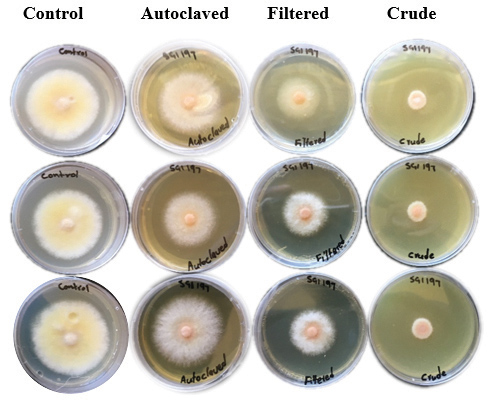
ARC-Small Grain, Bethlehem
 Dr Tshimangadzo Ramakuwela,
Dr Tshimangadzo Ramakuwela, ARC-Small Grain, Bethlehem
The underlying principle of integrated pest management (IPM) is based on minimising the use of chemical pesticides as these can be a threat to ecosystems and an expense to the economy.
An alternative strategy that is eco-friendly and economically sound is biological control. By definition, biological control is the use of living organisms to suppress the population density or impact of a specific pest organism, making it less abundant or less damaging than it would otherwise be (Eilenberg et al., 2001).
One such biological agent is entomopathogenic nematodes (EPNs) from the genera Steinernema and Heterorhabditis, which are lethal to a number of agriculturally important insect pests. EPNs have gained attention due to their many attributes as effective biological control agents and have been commercialised in several continents. In contrast to their obvious potential, the efficacy of EPN application is often challenged by a number of biotic and abiotic factors.
In nature, Steinernema spp. and Heterorhabditis spp. are symbiotically associated with insect-killing bacteria in the genera Xenorhabdus and Photorhabdus, respectively. The infective juvenile (IJ) is a non-feeding stage in the life cycle of EPNs and is the only infectious stage. These IJs search their host insect, infect and release the bacterial symbiont into the haemolymph of the insect. The bacterial symbiont kills the host and assists in establishing and maintaining favourable conditions for nematode development and reproduction by producing secondary metabolites that overcome the host insect’s immune system.
These metabolites inhibit the growth of various fungal and bacterial competitors, thereby ‘protecting’ the cadaver and resident EPNs. A number of secondary metabolites are produced, including lipases, phospholipases, proteases and peptides, which are understood to produce novel natural compounds with diverse biological activities. Metabolites of Photorhabdus and Xenorhabdus bacteria have demonstrated inhibitory effects against various fungal plant pathogens without phytotoxicity when applied to various plant species in the glasshouse. However, efficacy of metabolites produced by symbiotic bacteria of EPNs against Fusarium graminearum, the causative agent of Fusarium head blight (FHB) in small grains, has not been evaluated.
Management of FHB
FHB is a significant floral disease of cereals and poses serious health hazards by contaminating the grain with harmful mycotoxins. FHB development is mainly influenced by air, temperature and atmospheric humidity during flowering and early stages of seedling development. Worldwide, the disease is responsible for losses amounting to billions of dollars annually – with most of these losses in wheat and barley. In order to control FHB, chemical pesticides (triazoles and imidazoles) have been used for years.
Although chemical pesticide application forms a critical part of an integrated FHB management programme, they may also destroy natural antagonists of plant pathogens and facilitate resistance development to chemical pesticides. To date, there are no effective FHB control strategies available for producers despite its significance, underscoring the importance of research to address the challenges posed by this pathogen.
Recently, secondary metabolites produced by bacterial symbionts of indigenous South African EPN isolates (curated by the ARC-Small Grain) were evaluated for antifungal activity against F. graminearum group II. Antifungal activity was determined in two ways: firstly by comparing mycelial growth inhibition on treated versus untreated solid medium, and secondly by comparing spore germination percentage in treated versus untreated liquid medium. Antifungal activity varied significantly among isolates using the solid media technique.
The highest mycelial growth inhibition rate (96,25%) was achieved with a Xenorhabdus isolate, S. beitlechemi SGI 197, crude treatment after seven days incubation (Figure 1). For spore germination, isolates from the genus Xenorhabdus displayed higher inhibition of Fusarium spore germination compared to isolates of Photorhabdus. All Xenorhabdus isolates resulted in over 83% inhibition of Fusarium spore germination, while that of Photorhabdus isolates remained below 15% when compared to the control.

These results confirm that secondary metabolites from EPN bacterial symbionts are potential biofungicide candidates for control of FHB. Although field efficacy against FHB is still not studied, the significant inhibition of growth and spore germination suggests that application of secondary metabolites at flowering stage may provide protection of plants against infection or spread of F. graminearum. This research continues at ARC-Small Grain through funding by the Agricultural Research Council and the National Research Foundation, under grant number TTK180425324117.
Contact Dr Tshimangadzo Ramakuwela at 058 307 3400 or ramakuwelat@arc.agric.za for more information.
Reference
Eilenberg, J, Hajek, AE & Lomer, C. 2001. Suggestions for unifying the terminology in biological control.
BioControl 46, 387-400.





























